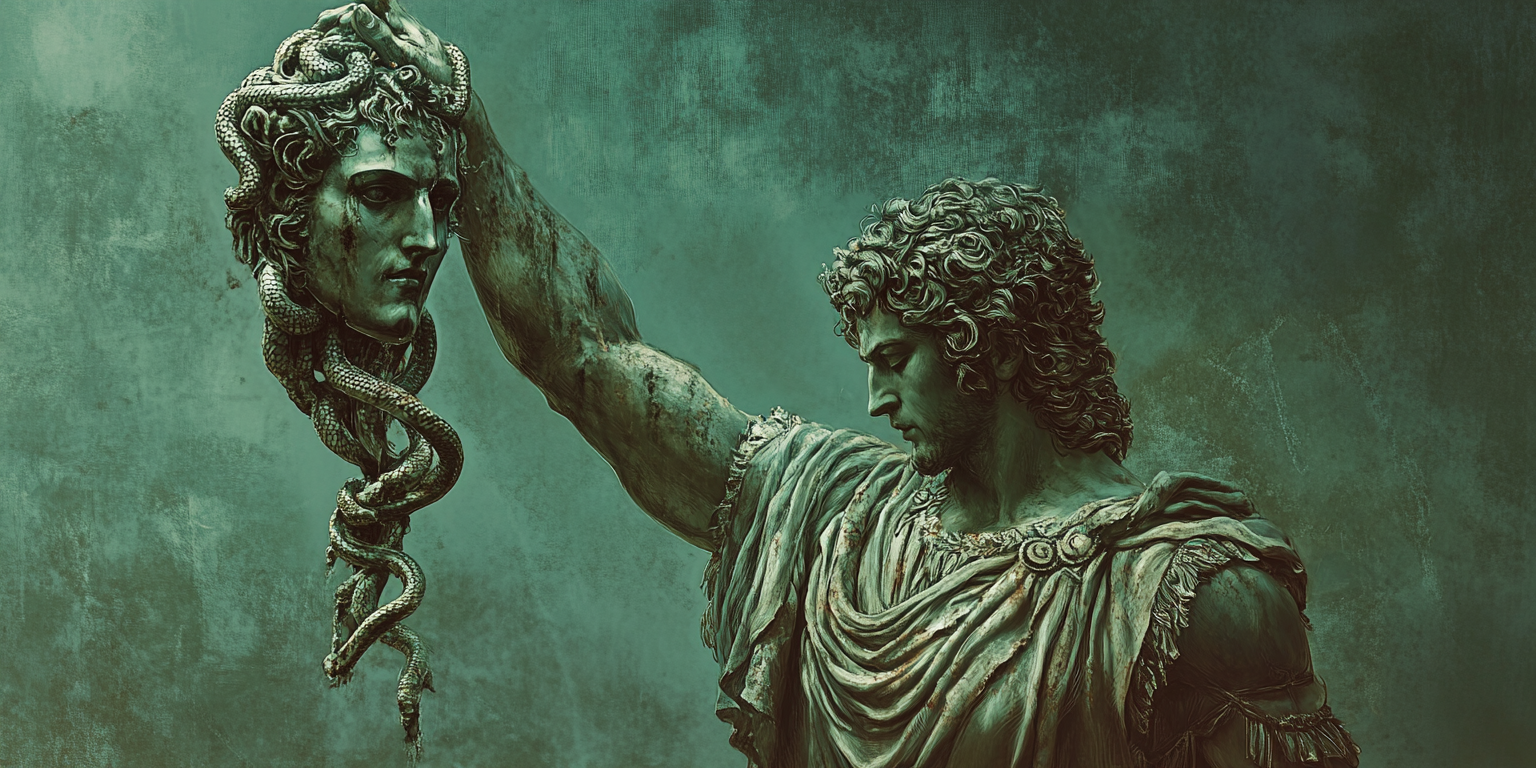Come with us on an adventure into the mythological tapestry surrounding Perseus, peeling back the layers of heroism, divine meddling, and poetic irony. This classic character from Greek mythology has attracted increased attention of late, due to the re-telling of his tale in the popular Percy Jackson book series by Rick Riordan (and its TV adaptation). Buckle up for the journey. This is not just any ancient tale; it’s a blockbuster of epic proportions.
The Birth of Perseus: A Prophecy Fulfilled
Perseus’s story begins not with a bang but with a prophecy. Acrisius, King of Argos, did what any self-respecting monarch would do upon hearing an oracle’s dire warning: panic. The prophecy declared that his grandson would one day bring about his demise. Acrisius’s solution? He locked his daughter Danaë in a bronze chamber to keep her out of reach of any suitors.
But Acrisius had clearly never dealt with Zeus, a god whose romantic escapades often defied physics and good sense. Zeus descended in the form of a golden shower (yes, really) through the cracks of Danaë’s prison, and thus Perseus was conceived. This act of divine infiltration birthed not only a hero but also a headache for Acrisius, who, upon discovering his daughter’s miraculous pregnancy, decided that locking her away hadn’t been drastic enough.
Father of the Year Acrisius opted for Plan B: tossing Danaë and her newborn into a wooden chest and setting them adrift at sea. Miraculously, the duo survived this ancient version of “Deadliest Catch” and washed ashore on the island of Seriphos, where they were taken in by the kind fisherman Dictys. He raised Perseus as his own, unaware that the boy was destined for greatness – and a great deal of drama.
Call to Adventure: Medusa's Head or Bust
Fast forward to adulthood, and Perseus found himself in the crosshairs of Polydectes, the scheming king of Seriphos. Polydectes had his sights set on Danaë but knew her son would be a major obstacle. To get Perseus out of the picture, Polydectes hatched a cunning plan: he demanded a wedding gift so extravagant it seemed impossible – a Gorgon’s head. Specifically, Medusa’s.
Let’s pause to appreciate the gravity of this demand. Medusa wasn’t just any monster; she was one of three Gorgons and the only mortal among them. With venomous snakes for hair and a gaze that turned anyone to stone, she was less “beatable boss” and more “living nightmare.”
Enter the gods. Hermes and Athena, clearly fans of Perseus’s underdog story, decided to kit him out for the journey. Hermes gifted him winged sandals for flight, while Athena provided a polished shield that would serve as both a mirror and a lifesaver. Hades lent his helm of invisibility, and Perseus picked up a magical satchel to safely store Medusa’s head. Armed to the teeth and brimming with divine endorsements, Perseus set off on his perilous quest.
Slaying the Gorgon: Strategy, Not Strength
Perseus reached the Gorgons’ lair, a nightmarish place littered with the petrified remains of less fortunate adventurers. Guided by Athena, Perseus used his reflective shield to navigate without looking directly at Medusa. In a move that was equal parts daring and ingenious, he decapitated her while she slept.
But Medusa had a final surprise: from her severed neck sprang Pegasus, the winged horse, and Chrysaor, a golden warrior. Packing up Medusa’s head in his magical satchel, Perseus fled the scene, narrowly avoiding her furious immortal sisters, Stheno and Euryale.
Andromeda: Love and Monsters
On his journey home, Perseus stumbled upon a sight straight out of a tragic opera. Andromeda, the daughter of King Cepheus and Queen Cassiopeia, was chained to a rock as an offering to a sea monster. This unfortunate predicament was thanks to her mother’s boast that Andromeda was more beautiful than the Nereids, sea nymphs who didn’t take kindly to insults.
Perseus, ever the opportunist, struck a deal: he would slay the monster in exchange for Andromeda’s hand in marriage. With Medusa’s head as his trump card, he made short work of the sea beast, freed Andromeda, and married her in a ceremony that probably didn’t involve a seating chart for sea monsters.
Back to Seriphos: A Hero Cleans House
Returning to Seriphos, Perseus found his mother under siege by Polydectes’s unwanted advances. Incensed, Perseus stormed the court and presented Medusa’s head, turning the king and his entourage to stone in an act of poetic justice. He installed Dictys as king, ensuring Seriphos would have a leader who wasn’t a walking harassment case.
The Prophecy Comes Full Circle
Now a seasoned hero, Perseus set out to reconcile with his grandfather Acrisius. Unfortunately, destiny had other plans. During athletic games in Larissa, Perseus accidentally killed Acrisius with a stray discus throw, fulfilling the original prophecy in the most ironic fashion possible. Stricken with guilt, Perseus refused the throne of Argos, instead founding the city of Mycenae and living out his days as a hero-turned-king.
Legacy: The Star Studded Hero
Perseus’s myth doesn’t end with his death. Immortalized in the stars as the constellation Perseus, he remains a symbol of bravery, resourcefulness, and a bit of divine nepotism. His story has inspired countless works of art, literature, and cinema, proving that while trends come and go, a good monster-slaying tale never goes out of style.
For readers eager to explore more, here are recommended readings and sources for further mythological deep dives:
- The Library of Greek Mythology by Apollodorus
- Metamorphoses by Ovid
- The Greek Myths by Robert Graves
- Mythology by Edith Hamilton
- Perseus and Medusa: A Graphic Novel by Blake Hoena
Perseus was not just a hero but a harbinger of a timeless truth: even in the face of monstrous odds, a sharp mind (and divine allies) can carve out a legend.
At Ancient Theory we only use trusted sources to document our articles. Such relevant sources include authentic documents, newspaper and magazine articles, established authors, or reputable websites.






